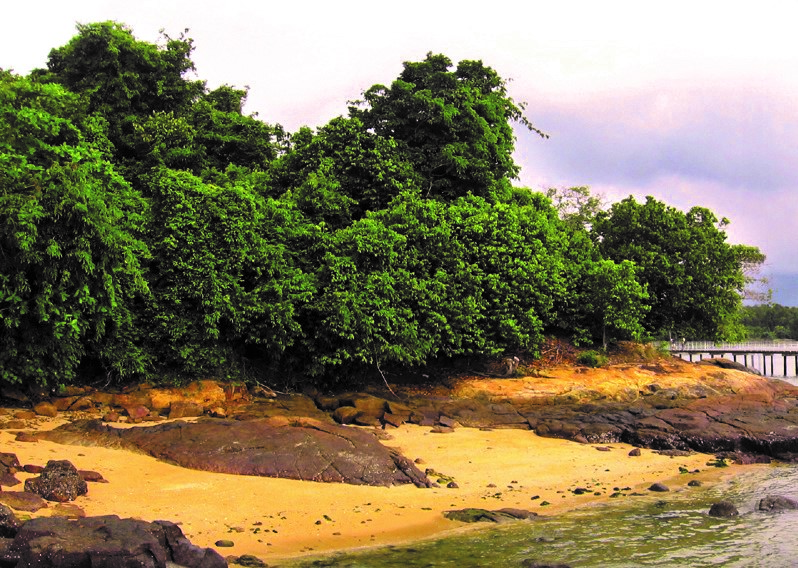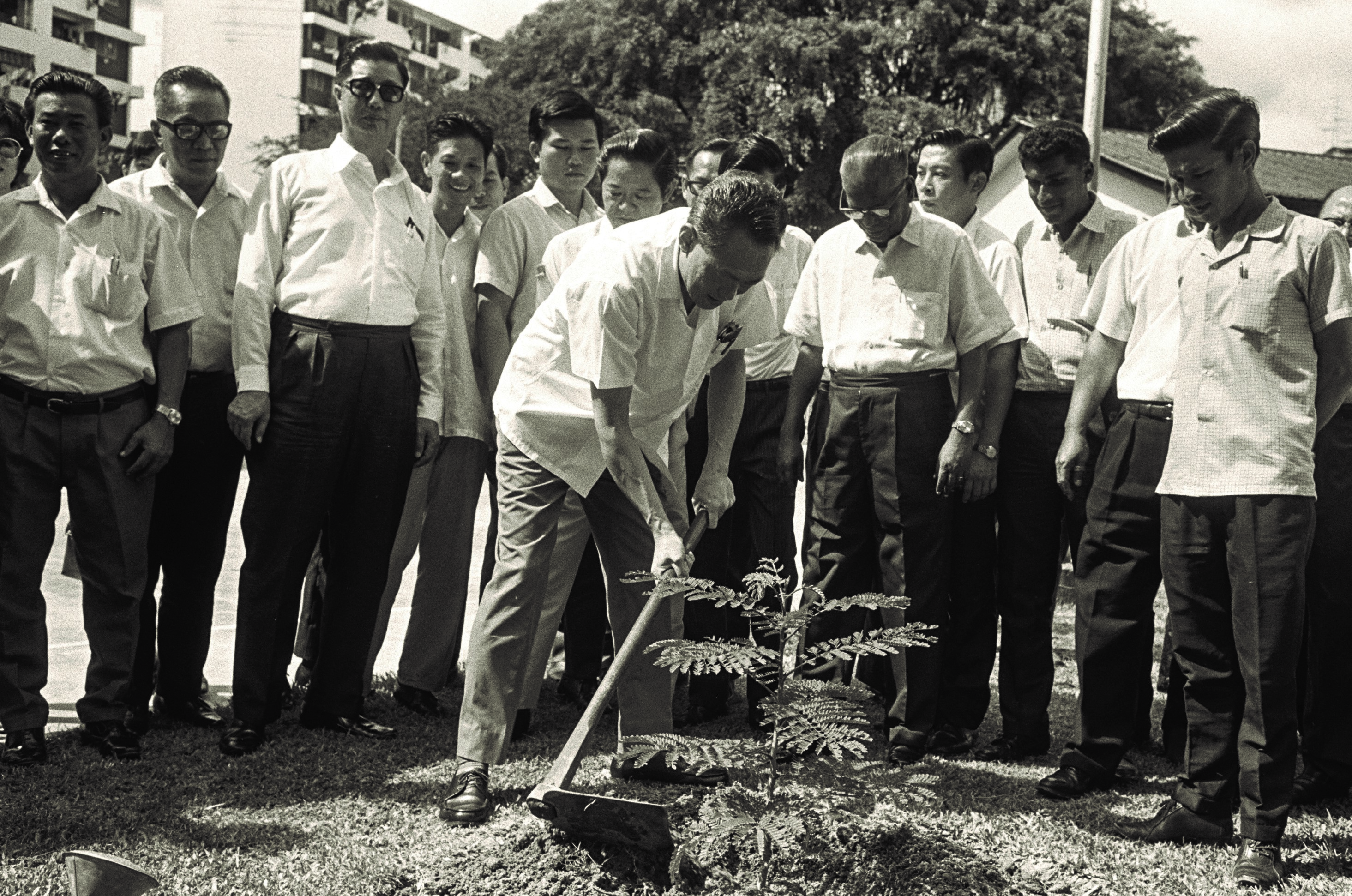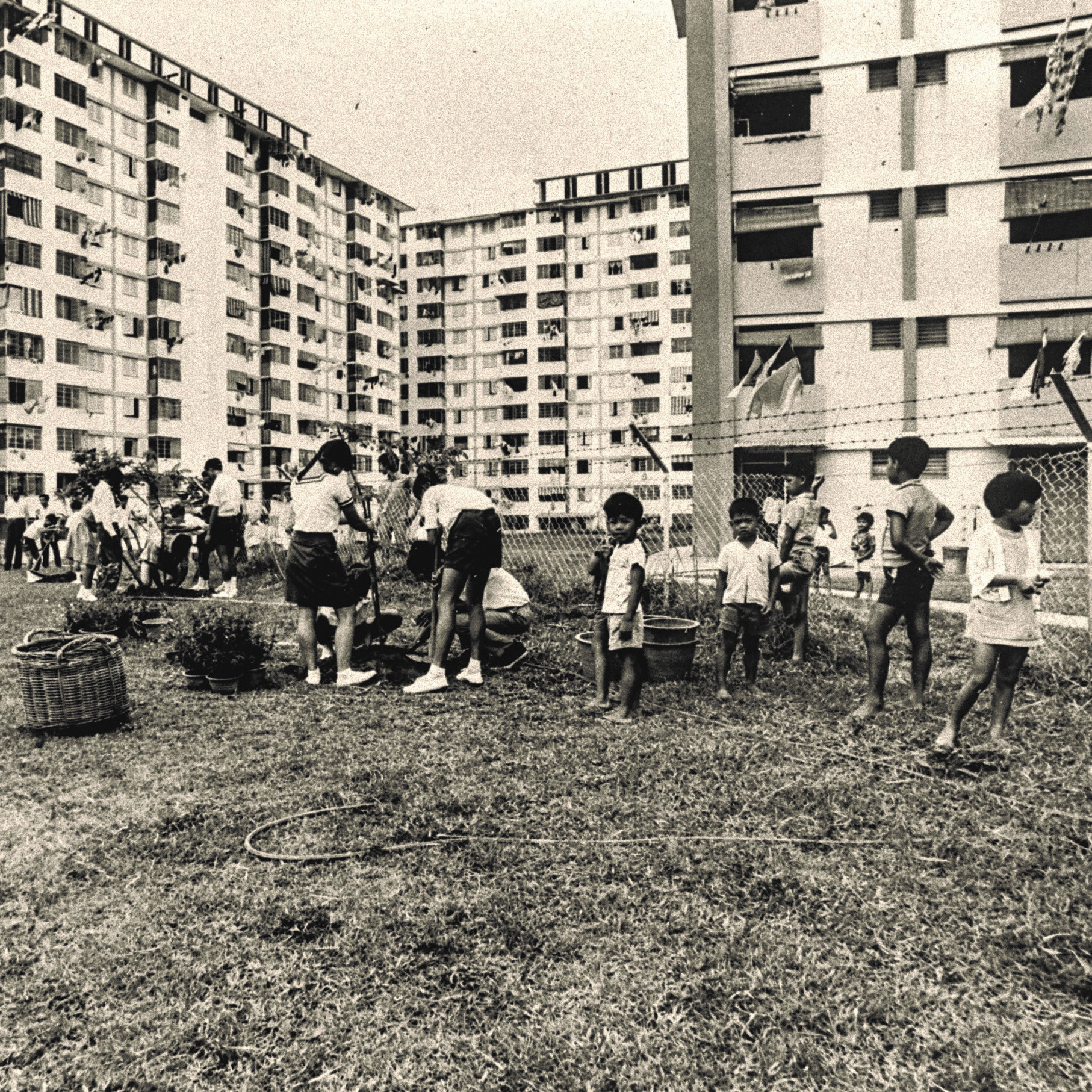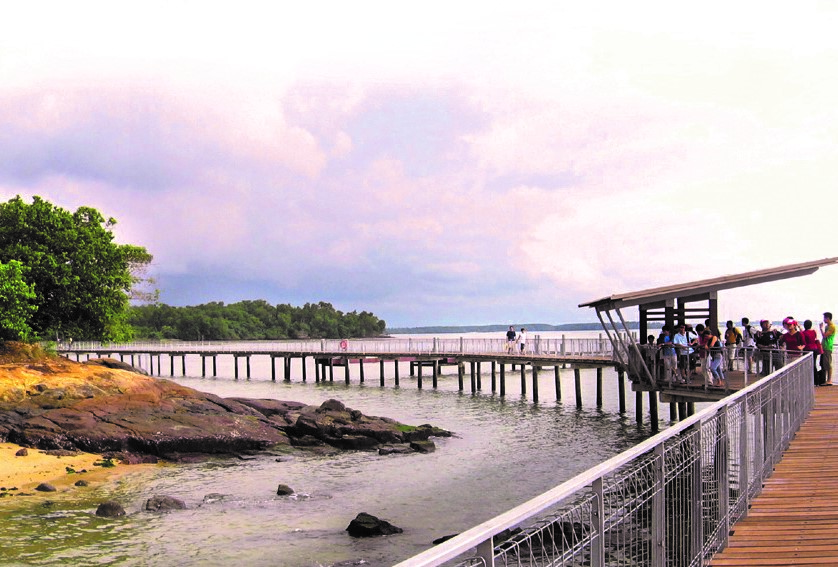From Garden City to Gardening City
What started five decades ago as a government-led project to build Singapore into a clean and green city has today become a dialogue between the state and its citizens.

A Straits Times photo of former Prime Minister Lee Kuan Yew launching Singapore’s first-ever tree-planting campaign in 1963 best depicts how the idea of building Singapore into a Garden City first took root. As Mr Lee bent over to dig a hole with a changkol to plant a Mempat tree at Farrer Circus, Singaporeans stood around and watched – none of them offering a helping hand.

Fast forward to 2012, and one finds a different landscape in the Garden City. In August, a group of residents in Limau estate petitioned the government to conserve a stretch of greenery near their homes instead of selling the land for development. This was not an isolated case. In that year alone, residents in Dairy Farm, Pasir Ris and Clementi also clamoured for green plots near their estates to be preserved, using what has since become a tried-and-tested method of engaging the government: banding together to write petitions and meeting their members of Parliament to convey their thoughts and concerns.
In a span of five decades, the transformation of Singapore into a Garden City is no longer a project that only the government is concerned with. While the state dictated how Singapore was to be greened in the past – from the choice of trees and shrubs, right down to where exactly to plant them – Singaporeans now want a say too. In response, the government’s approach has evolved, which led to more spaces for the grassroots to grow with this national initiative.
Seeds of a Garden City
Although the tree-planting campaign started in 1963, it was only five years later that a more fleshed-out concept to turn Singapore into a green environment was introduced. In 1968, the idea of the Garden City was first announced by the then Minister for Health Chua Sian Chin, who said during the second reading of the Environmental Public Health Bill: “The improvement in the quality of our urban environment and the transformation of Singapore into a garden city – a clean and green city – is the declared objective of the Government.”1
In those early years, the government tried to soften the impact of concrete development as a result of Singapore’s modernisation. It became the lead designer to turn Singapore into a Garden City, starting with an simple plan: to camouflage the concrete in a blanket of green, using the most efficient and cost-effective methods to ensure that life in this up-and-coming tropical city was both shady and cool.2 Trees were planted everywhere, along roads and at open spaces, and species such as the angsana and pong pong were favoured because they grew fast and to heights that matched the rapid pace of urbanisation.
Such thinking prevailed for over a decade until 1980 when the developing city-state felt it deserved and could afford more quality in its green environment. To break the monotony of green, colour was added into the Garden City by introducing flowering trees and shrubs, including species like the bougainvillea, hibiscus and ixora, as well as fruit trees such as the mango, jackfruit, guava, jambu and some citruses. As then Prime Minister Lee outlined in his vision of the future, “By the 1990s, Singapore can become a green, shady city filled with fruits and flowers, a city worthy of an industrious people whose quest for progress is matched by their appreciation for the beauty of nature.”3
Singapore indeed blossomed in the 1990s, becoming recognised not only as an economic miracle, but also as a clean and green city. The government then set out on an even more ambitious goal.
In the 1991 Concept Plan formulated by the Urban Redevelopment Authority (URA) for the long-term infrastructure planning of Singapore, it was proposed that the future city was one where nature and the urban environment would be seamless. Former URA chief Liu Thai Ker explained: “It is a case not so much of bringing nature into urban development but bringing urban development into nature.”4 Over the last two decades, this has become known as Singapore’s transformation from a Garden City into “A City in a Garden”, as illustrated with new features such as the Park Connector Network that allows one to easily jog, skate or cycle across the different parks located around Singapore. The crown jewel of the new “City in a Garden” is Gardens by the Bay, opened in 2012. Not only is this green space in the heart of the city’s financial centre, Marina Bay, it is also where nature from all around the world can be found in its two conservatories. The gardens underscored Singapore’s ambitions to be a global city, as Prime Minister Lee Hsien Loong said at its official opening: “[We] could have used this for far more valuable commercial or residential developments, right in the middle of the new Singapore city. But our planners in URA believed that a large and beautiful park was an important element of our new downtown in Marina Bay South, just like Central Park in New York or Hyde Park in London.”5
A Grassroots Movement
From the beginning, the government has tried to involve citizens in the making of the Garden City. In the second tree-planting campaign in 1964, then Minister for Social Affairs Othman Wok told the press how the project was more than just about planting the seeds of a green city, but that of a nation too. “Each tree planted in a public cooperative effort like this operation serves as a symbol of the unbreakable bonds that united the people and the Government in their common task of nation building,”6 he said.
Besides rallying people and corporations to participate in tree-planting efforts, the government also tried to bring about wider community involvement in the 1970s by introducing tax reliefs for households that cultivated their own private gardens.7 With an increasing number of Singaporeans living in public housing by the 1980s, the government also started planting fruit trees in the estates’ common areas so that residents could maintain the gardens together and in the process develop a community spirit amongst themselves.8 This was the hope expressed by Lee Kuan Yew, when he introduced this new stage of development for Singapore’s ambitions to become a Garden City. However, he also anticipated potential problems. “We have the knowledge; we have the artistic touch. We can now afford the cost. The question is, can we do it in such a way as to avoid vandalism or theft, without severe security measures which will destroy the aesthetic impact?,” he asked. Adding that better fruit trees would only be planted later when higher social standards were the norm, he said, “Gradually, both at home and in the schools, we can nurture a generation that will have the social discipline to respect and share the fruits of communal property.”9

As it turned out, Residents’ Committees, which were in charge of the fruit trees, struggled to upkeep them and were soon calling for the government to step in and maintain them instead. While some estates could not find enough manpower to harvest so many fruits10, others could not stop the theft of fruits, and fines of up to $1,000 had to be introduced.11 But it was not that residents were uninterested in gardening. Many of them had been resettled from kampongs where they once lived close to nature. These residents continued to garden in their private apartments, even though high-rise housing was not the most optimal space for gardening. As residents tried to find alternative spaces in the public housing estate to garden, they found their efforts hampered. While residents could keep plants in the common corridors of their high-rise flats, they should not cause obstruction or pose danger to others – subjective rules that led some residents to assume there was an outright ban.12 When some residents in a housing estate along Boon Tiong Road began planting in the common area of their estate, they were issued notices from public housing officials to remove their “unsightly plants”.13 Residents had to come to terms with the state’s notion of what constituted a garden.
An Organic Growth
In 1988, a civic organisation showed how citizens could participate in the Garden City project besides being part of official state programmes when it convinced the government to conserve Sungei Buloh. The Malayan Nature Society’s Singapore Branch, which has since become the Nature Society of Singapore (NSS), came up with a conservation proposal for a nature site that had been scheduled for development as an agro-technology park. In 1986, a member of the society, Richard Hale, had stumbled upon Sungei Buloh’s mangrove and prawn ponds and discovered that it was full of birdlife. When the banker learnt of the state’s plans to develop it, he led a group of NSS members to document the richness of the site and formulate a counter-proposal. Plans submitted to the government in 1987 suggested Sungei Buloh be kept as a 318-hectare nature reserve, providing a sanctuary for birds and birdwatchers. In time, it could also become a major tourist attraction and education centre for students. To aid the cause, Hale even personally escorted President Wee Kim Wee, Deputy Prime Minister Goh Chok Tong and Minister for National Development S. Dhanabalan to Sungei Buloh. These efforts eventually convinced the government to conserve part of the area, and Sungei Buloh was declared a nature park in 1988.

Sungei Buloh was the first postcolonial allocation of land for nature conservation,14 and the society’s approach became a template adopted by later initiatives when engaging the state: doing research and creating professional reports, formulating concrete counter-proposals, as well as winning public opinion and convincing members of the government. The decision by the state to agree with the society’s proposal was also seen to be what became an “inescapable collaborative manner of governing”.15
This was reflected in the case of Chek Jawa wetlands in 2001. Located on the island of Pulau Ubin, Chek Jawa had already been slated for reclamation since 1992, but a chance discovery in 2000 of its rich biodiversity led a group of volunteers to follow in the footsteps of the NSS and come up with a report on Chek Jawa’s natural heritage and a petition to the government for the conservation of this natural habitat.
The government surprised many by agreeing to do so, promising to leave Chek Jawa untouched for the next 10 years. After the decision was made, Minister for National Development Mah Bow Tan said: “Has there been any change in our thinking? No. What has changed is the environment. Over the past 10 years, people’s awareness of heritage and conservation issues has become more acute. The Government has also become more aware of the need to accommodate this… giving people a sense of belonging to Singapore.”16
The intent was not radically different from what Othman Wok said at the 1964 tree-planting campaign – that getting citizens involved in a project such as making Singapore into a Garden City was a way of nation-building. However, as suggested by Mah, the government’s approach had changed, and it was opening up more space for citizens to participate. This was confirmed in 2003 when the Garden City Fund was launched to encourage individuals and organisations to get involved. As then Deputy Prime Minister Lee Hsien Loong said at its launch, “In the past, the Government played a lead role in realising the vision of a garden city… However, as Singapore matures as a society and our people develop a natural affinity for greenery, the Government’s role should increasingly be complemented by civic participation.”17
From Garden City to Gardening City
Concrete change in the government’s approach can be seen in projects such as Community in Bloom. Reminiscent of the earlier initiative to plant fruit trees in housing estates in the 1980s, the National Parks Board (NParks) launched this project in 2005 so that people could start community gardens in public and private housing estates, educational institutions and organisations such as hospitals. The aim was to “foster a gardening culture among the people in Singapore”,18 and unlike earlier efforts where residents were tasked to take care of trees planted by the state, community gardens were initiated by individuals in the community.
Together, the people would decide what to plant in the gardens and how so, while NParks would act as a facilitator, offering gardening tips and helping residents navigate the thorny issue of land ownership by seeking permission from relevant agencies. In the last seven years, some 480 community gardens have been set up across the island.19 Community in Bloom was a way in which the state could allow citizens to participate in building the Garden City still within its purview. As a news report on the programme last year highlighted, this was a viable alternative against the issue of citizens gardening illegally on state land, saying there was “no need for keen gardeners here to break the law”.20
A more prominent project that had Singaporeans take the lead in gardening the city was the Butterfly Trail @ Orchard. Started by the NSS in 2010, this was a four-kilometre-long green corridor that cuts through the heart of Singapore’s shopping district. The NSS partnered NParks, Singapore Tourism Board and Orchard Road Business Association to create “butterfly hotspots”, propagating plants that provide food and shelter for butterflies along the stretch from the Botanic Gardens through Orchard Road to Fort Canning. This project came about after the President of Singapore had rejected NSS’s proposal to plant a species of vine in the Istana’s garden to attract butterflies to the Orchard Road area in 2008.21 The NSS was then introduced to volunteer Margaret Clarkson, who together with the Singapore Environment Council, had also been thinking about increasing the number of butterflies in Singapore. Inspired by Singapore’s garden city concept, Clarkson suggested creating an urban butterfly trail.22 At the end of 2012, three of the five sections that make up this walking trail had been completed, and it has attracted 62 of about Singapore’s 300 known butterfly species to the urban jungle thus far.23
Perhaps no better project showcases the government’s changed approach to working with citizens in its pursuit to become a “City in a Garden” than the ongoing Rail Corridor development. It has often been cited by ministers and members of Parliament as an example of how the government and citizens can work together on the issue of development. In September 2010, Malaysia and Singapore reached a historic land swap agreement. A stretch of land that Malaysia’s railway line had been running on for decades was returned to Singapore in exchange for parcels of land elsewhere in the city. The land, which spans the north and south of Singapore, connecting its northern tip in Woodlands to the city’s Central Business District in Tanjong Pagar, had become akin to a nature park as it was left untouched by Singapore’s urbanisation over the years. A few days after the land swap, NSS vice-president Leong Kwok Peng wrote in to the newspaper suggesting for the land to be converted into a nature corridor. The society then followed up with a detailed proposal to the government. This started a public discussion that received much attention in the media and online.
The government soon weighed in favourably on this, and even invited public feedback and suggestions. By July 2011, Minister of State for National Development Tan Chuan-Jin, who was leading this development project, had formed an informal work group with various people from the nature and heritage groups, as well as architects and academics, to chart the future of the land24 and even explored the stretch with them. The group was later formalised as the Rail Corridor Partnership, formed to “look into the programming and promotion of suitable community activities and events along the Rail Corridor”.25 Over the last year, workshops and exhibitions have been put up to explore the possibilities of developing the land, while there have also been runs and walks organised for the public to enjoy the stretch.
As Leong noted, the Rail Corridor development “signals the Government’s readiness to collaborate and engage civil society groups at a deeper level”.26 Unlike Sungei Buloh and Chek Jawa, the government consulted and engaged citizens from early on in the formulation of the future of the Rail Corridor, even including them as part of discussions in an informal work group that became a formal partnership. As Tan said in the Budget debates last year, this was an example of “cocreation”,27 where the government was empowering citizens to participate in the making of the “City in a Garden”.
In a sense, this has allowed citizens to become “gardeners” of this “City in a Garden”, where they are not passive consumers of a landscape defined by someone else, but active participants in shaping it. In this area, citizens have been able to make a significant impact on Singapore’s policymaking process.
It is also interesting to note that most calls by citizens have been for the preservation of existing nature as opposed to the building of gardens. It is perhaps a reflection that at its core, the government still sees nature as a means to soften the city landscape as opposed to an end in itself. It holds a strong belief in “constructing” a clean and green environment, as opposed to giving nature the space to grow. This is also seen in the city’s increasing lack of open green spaces. The only time they exist are when buildings are demolished, creating empty lands that exist until new construction begins on them.
Such a mindset is worrying because there may come a point in time where the only definition left of nature is that of a garden. For now, one must be stubbornly optimistic and say that Singapore as a “City in a Garden” is no longer a static and monolithic one, as it has been over the decades. The garden is now blossoming with diverse voices – from citizens, nongovernmental organisations and even corporations – that reflect a rich landscape. Some may want to call it a “messier” kind of garden, but another way of looking at it is to simply appreciate the beauty of nature as it evolves organically.
 Justin Zhuang writes about and researches Singapore’s visual culture, heritage and spaces under the auspices of In Plain Words (https://inplainwords.sg/)
Justin Zhuang writes about and researches Singapore’s visual culture, heritage and spaces under the auspices of In Plain Words (https://inplainwords.sg/)
REFERENCES
Ang, I. (1988, November 22). Fruit theft a common problem. The Straits Times, p. 24. Retrieved from NewspaperSG.
Bringing highrise residents closer to nature. (1977, July 30). The Straits Times, p. 15. Retrieved from NewspaperSG.
Burst of colour to enhance garden city. (1980, September 18). The Straits Times, p. 9. Retrieved from NewspaperSG.
Campbell, W. (1972, April 10). Garden city concepts gets lift. The Straits Times, p. 14. Retrieved from NewspaperSG.
Chong, W.L. (1977, November 6). Untitled. The Straits Times, p. 12. Retrieved from NewspaperSG.
Francesch-Huidobro, M. (2008). The power of persuasion: Conserving Sungei Buloh (pp. 165–220). In Governance, politics and the environment: A Singapore study. Singapore: Institute of Southeast Asian Studies. (Call no.: RSING 320.58095957 FRA)
Fruit trees to nurture community spirit. (1985, November 16). The Straits Times, p. 12. Retrieved from NewspaperSG.
Glauberman, S. (1985, August 25). Fruits of labour are going to waste. The Straits Times, p. 3. Retrieved from NewspaperSG.
Lee begins the tree campaign. (1963, June 17). The Straits Times, p. 7. Retrieved from NewspaperSG.
Lee, S.K. (1995). Concept of the garden city (pp. 129–147). In G.L. Ooi (Ed.), Environment and the city: Sharing Singapore’s experience and future challenge. Singapore: Institute of Policy Studies. (Call no.: RSING 363.70095957 ENV)
Leong, C.T. (1991, September 12). Blueprint for a city of diversity and grace. The Straits Times, p. 1. Retrieved from NewspaperSG.
Lim, L. (2002, January 15). Govt open to feedback on conservation issues. The Straits Times, p. 2. Retrieved from NewspaperSG.
National Parks Board. (2019, March 29). Community in bloom – Singapore’s National Gardening movement. Retrieved from National Parks Board website.
Nature Society (Singapore). (2011). Butterfly & insect group. Retrieved from Nature Society (Singapore) website.
Pang, P. (2003, December 3). Green tax breaks. Today, p. 6. Retrieved from NewspaperSG.
Quek, T. (2010, January 4). How the idea of a city nature trail came about. The Straits Times, p. 15. Retrieved from NewspaperSG.
Saifulbahri Ismail. (2012, June 28). Decision to build Gardens by the Bay not an easy one: PM Lee. ChannelNews Asia. Retrieved from ChannelNews Asia website.
Singapore. Parliament. Parliamentary Debates: Official report. (1968, December 16). Second Reading of the Environmental Public Health Bill (Vol. 28). Singapore: [s.n.]. (Call no.: RCLOS 328.5957 SIN)
Sit, M. (1980, September 4). Plants must go order incurs wrath of residents. The Straits Times, p. 7. Retrieved from NewspaperSG.
Tai, J. (2012, December 10). A vote to capture the National butterfly. The Straits Times, pp. 4–5. Retrieved from NewspaperSG.
Tan, A. (2011, July 11). Informal group to discuss railway land use. The Straits Times, p. 15. Retrieved from NewspaperSG.
Tan, C.-J. (2012, March 6). Celebrating & co-creating a rooted community. Retrieved from Ministry of National Development website.
Teo, W.G., & Toh, Y.C. (2011, December 30). Campaign for a green corridor. The Straits Times, p. 20. Retrieved from NewspaperSG.
Three Ministers lead the tree planters. (1964, March 9). The Straits Times, p. 5. Retrieved from NewspaperSG.
Urban Redevelopment Authority (Singapore). (2012, May 12). URA establishes rail corridor partnership to explore and promote community activities along rail corridor [Press release]. Retrieved from URA website.
Wee, C.F. (2012, March 18). Garden scheme blooms. The Straits Times, p. 6. Retrieved from NewspaperSG.
Wee, Y.C., & Hale, R. (2008). The Nature Society (Singapore) and the struggle to conserve Singapore’s nature areas. Nature in Singapore, 41—49.
NOTES
-
Singapore. Parliamentary Debates: Official Report, 16 Dec 1968. ↩
-
The Straits Times, 18 Sep 1980, p. 9. ↩
-
Ismail, 28 June 2012. ↩
-
The Straits Times, 9 Mar 1964, p. 5. ↩
-
The Straits Times, 16 Nov 1985, p. 12. ↩
-
The Straits Times, 18 Sep 1980, p. 9. ↩
-
Glauberman, 25 Aug 1985, p. 3. ↩
-
The Straits Times, 30 Jul 1977, p. 15; Chong, 26 Sep 1977, p. 12. ↩
-
Wee & Hale, 2008. ↩
-
Francesch-Huidobro, 2008. ↩
-
National Parks Board, Community in Bloom, 29 Mar 2019. ↩
-
Nature Society (Singapore), Butterfly & insect group, 2011. ↩
-
Urban Redevelopment Authority (Singapore), URA Establishes Rail Corridor Partnership to Explore and Promote Community Activities Along Rail corridor, 12 May 2012. ↩
-
Tan, Celebrating & Co-Creating a Rooted Community, 6 Mar 2012. ↩

